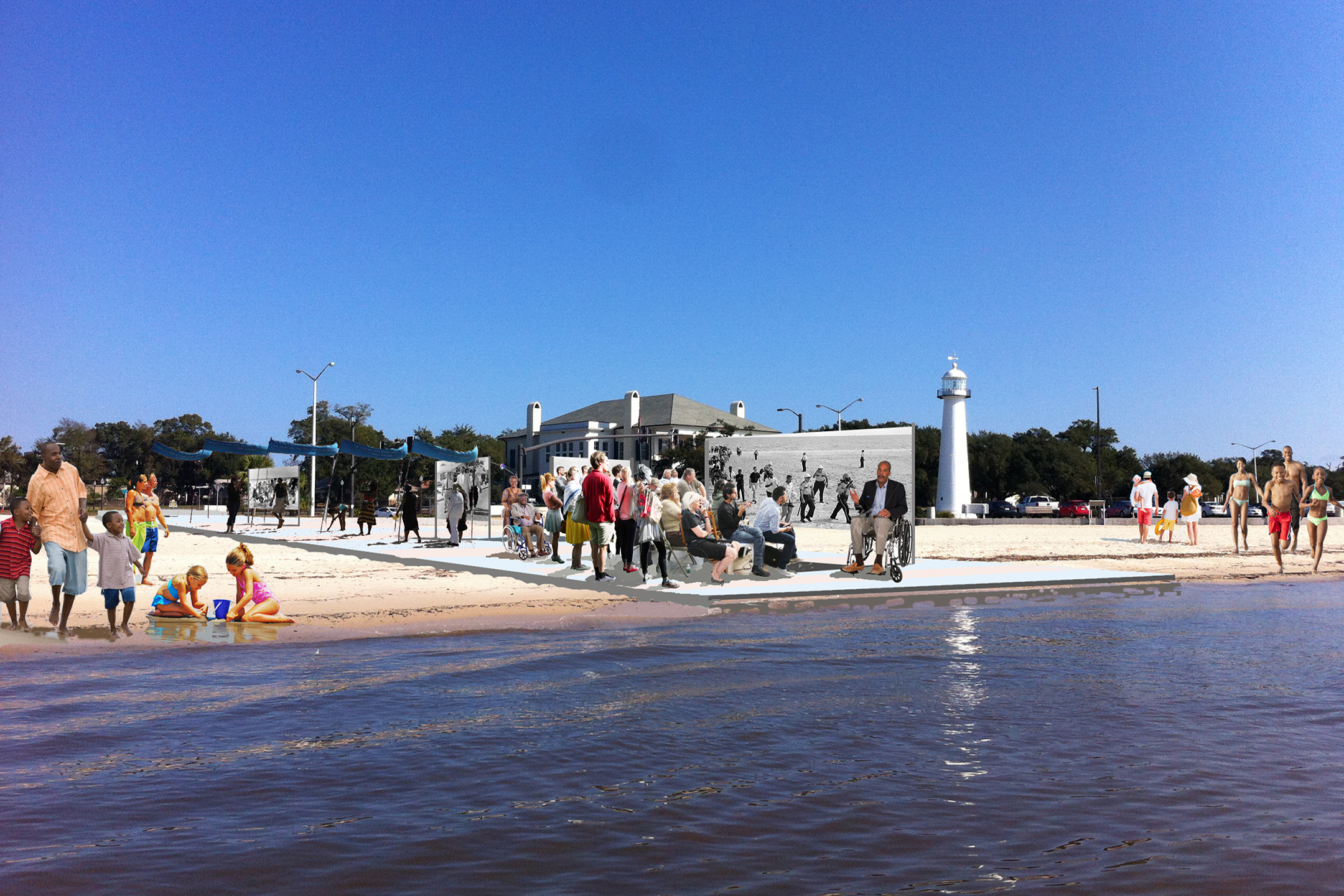
Not quite a year before the famous sit-in in Greensboro, N.C., became a civil-rights milestone, activists in Biloxi, Miss., decided to tackle segregation in a place that required more than sitting: the ocean.
On May 14, 1959, several Biloxi residents — led by Dr. Gilbert Mason — staged a “wade-in” to protest the segregated Gulf Coach beach. As Mason would later write in his book Beaches, Blood, and Ballots: A Black Doctor’s Civil Rights Struggle, that first 1959 wade-in “marked the beginning of Mississippi’s first nonviolent civil disobedience campaign.”
Other wade-ins would follow, though it would take about a decade for a judge to declare that the beach had to be open to all. Now, a project that commemorates those wade-ins has been named one of the winning ideas in the annual Knight Cities Challenge, a $5 million competition that awards ideas to improve cities. The 2017 crop, announced this week, includes the Gulf Coast Community Design Studio‘s concept for a public project that creates spaces on the beaches of Biloxi for citizens to meet where the protests took place, and for a pop-up event at which witnesses and others will discuss the wade-in as well as modern issues of race in community.
“I suspect [the wade-ins] sort of got overshadowed by some of the activities that followed later,” David Perkes, director of the Design Studio. “But they established a public beach that’s still important on the Gulf Coast.”
Not that the wade-ins progressed easily. As the National Park Service explains in its overview of civil rights in public accommodations, the police officer that informed Mason and his fellow waders in 1959 that he was removing them from the beach because “a municipal ordinance prevented blacks from using the beach reserved exclusively for whites” was wrong. There wasn’t any law to that effect, but local law enforcement and homeowners worked together to enforce segregation on the beaches. And they did so violently, especially following a wade-in on April 24, 1960, as TIME reported shortly after:
With the coming of the South’s sultry summer, Negroes intend to turn the heat on a new front in their campaign against segregation. Sit-ins at segregated lunch counters will give way to “wade-ins” at segregated public beaches. “Negroes get hot just like white people do,” said the N.A.A.C.P.’s Executive Secretary Roy Wilkins in announcing the new tactic last week. “They like to swim to cool off, and intend to do it this summer.”
Mississippi Negroes stuck a tentative toe into white waters fortnight ago on Biloxi’s sun-drenched beach along the Gulf of Mexico. Led by Dr. Gilbert Mason, 31, Biloxi’s only practicing Negro physician, 80 Negro men, women and children waded into the gulf, were driven off by a gang of club-wielding, chain-swinging whites. The Negroes have not been back. The new wade–in assault, said Wilkins, will aim at segregated, tax-supported beaches and parks in eleven states along a 2,000-mile coastline curving from Cape May, N.J. to Brownsville, Texas.
The violence against protesters and other black Biloxi residents continued into the night — becoming by some accounts Mississippi’s bloodiest race riot in state history — to which civil-rights advocates responded with a boycott. Dr. Mason, who had led the protests, became head of the newly formed local NAACP branch. (Mason’s son, who was about 5 at the time, participated in a commemorative event this past April in Biloxi, the local Sun Herald newspaper reported.) Another wade-in took place in 1963, in tribute to the recently assassinated Medgar Evers, and the practice spread to other regions as well.
As Smithsonian.com’s Matthew Pitt has explained, the question of whether the beach was public or private space was a complicated one: via the Army Corps of Engineers, taxpayers had contributed to the structure of the beach, and yet the individuals who owned homes near the water claimed that their private property extended all the way to the water. If the beach were public, all citizens, regardless of race, ought to have had use of it. If the beach were private, only the homeowners and their guests could use it — but the beaches weren’t, in practice, private. White citizens used them freely. When the ruling on desegregation finally came down, it was declared that in fact the beaches were public, and that “public” meant “for everyone.”
“Part of the importance of this story is that the beaches are now taken for granted, that they’re public,” says Perkes. “The story itself, for me, is important to be told not only as far as history is concerned, but for the realization of the important strategies behind civil rights – not just protest, but all the legal efforts required to bring about a change in the law when the law is biased against you. Protests don’t bring about change on their own. It takes a lot of work to make that protest have a legal impact.”
That’s part of the reason why he believes it matters so much for members of the community to hear from the people who remember the wade-ins, especially as they get older and their numbers diminish. Those attempting to address the challenges facing Biloxi’s African-American community today, he says, can be seen as part of an important long-term history of making progress in the city. “We want to talk about that,” he says. “There are still great challenges, but the lines of protest are harder to see. ‘Change is possible’ is what people should take away from it.”
More Must-Reads from TIME
- Donald Trump Is TIME's 2024 Person of the Year
- Why We Chose Trump as Person of the Year
- Is Intermittent Fasting Good or Bad for You?
- The 100 Must-Read Books of 2024
- The 20 Best Christmas TV Episodes
- Column: If Optimism Feels Ridiculous Now, Try Hope
- The Future of Climate Action Is Trade Policy
- Merle Bombardieri Is Helping People Make the Baby Decision
Write to Lily Rothman at lily.rothman@time.com